
NGC 5829, 13m1, 1.7' x 1.5'
IC 4526, 15m8, 0.4' x 0.3'
Distance: NGC 5829 approx. 260 MLy, IC 4526 approx. 600 MLy
Bootes
Uranometria: S. 153 (old), S. 70-left (new)
DSS II (5' x 5')
further information:
SDSS Image
Messier45.com
not observed yet

NGC 5994, 14m8, 0.4' x 0.2', SB?
NGC 5996, 12m5, 1.8' x 0.9', S?
Distance: approx. 150 MLy
Serpens Caput
Uranometria: S. 155 (old), S. 69-right/88-left (new)
DSS II (5' x 5')
further information:
SDSS Image
Messier45.com
not observed yet

NGC 702, 13m1, 1.6' x 1.2', SAB(s)b: pec
Distance: approx. 500 MLy
Cetus
Uranometria: S. 218 (old), S. 119-right/120-left (new)
DSS II (5' x 5')
further information:
Messier45.com
not observed yet

Messier 90, 9m4, 9.7' x 4.4', SAB(rs)ab
IC 3583, 13m3, 2.2' x 1.1', IBm
Distance: approx. 50 MLy
Virgo
Uranometria: S. 194 (old), S. 90-right/91-left/A 13 (new)
DSS II (10' x 10')
further information:
SDSS Image
Messier45.com
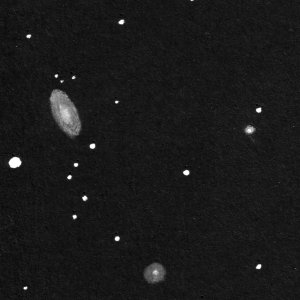
Uwe Glahn, 20x125, fst 6m4:
in the bino bright, 1:2 elongated galaxy, bright nucleus, companion IC 3583 not observed
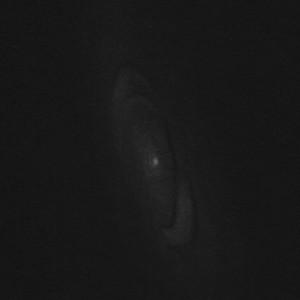
Uwe Glahn, 16", 100x - 300x, fst 6m8:
main body of M 90 1: 3 NE - SW elongated; spiral structure difficult even with 16"; to the SW longish part; to the NE two fainter bended structures; outer region very faint and only visible with middle AP; companion IC 3583 faint 1:2 N - S elongated structure

Martin Schoenball, 10",91x, fst 6m2:
Large galaxy with pretty low surface brightness. It does not get brighter towards the middle but features a very bright core. The galaxy has some low contrast brighter regeion. A bar runs inclined through the center. The galaxy is elongated 4:1 and has tapered ends.
Matthias Juchert, 2,5", fst 6m4:
Large, oval nebula elongated at PA 30°. The pretty low surface brightness und the moderately bright core lead to the assumption of a spiral galaxy even with small telescopes.

NGC 770, 13m0, 1.1' x 0.7', E3
NGC 772, 10m3, 7.3' x 4.3', SA(s)b I +
Distance: approx. 110 MLy
Aries
Uranometria: S. 129 (old), S. 79-right/80-left (new)
DSS II (10' x 10')
further information:
Messier45.com
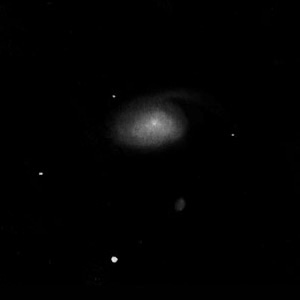
Matthias Juchert, 8", fst 6m3:
NGC 770: Only 3' south of the core of NGC 772 lies this small, and pretty high surface brightness galaxy. It is only visible with averted vision, but appears pretty easy as a small oval nebula at 126x.
NGC 772: NGC 772 is visible with direct vision, but not as bright as the 10m3 indicate, nevertheless the faint, ellipse shows up at 50x. A very much brighter core with a stellar nucleus lies off center in the halo. The halo itself is unusual. At 98x and averted vision a faint extension is visible at the north-west side. There is dark space between the extension and the galaxy body - one spiral arm is visible with 8"!

Uwe Glahn, 20", 434x, fst 6m5:
NGC 772 large, circular, nucleus elongated, visually smaller than it's specification, dominating arm only visible as two faint condensations, NGC 770 bright, circular, with high surface brightness

NGC 6621, 13m2, 2.1' x 0.8', Sb: pec
NGC 6622, 15m0, 0.5' x 0.4'
Distance: approx. 290 MLy
Draco
Uranometria: S. 30 (old), S. 10-right (new)
DSS II (5' x 5')
further information:
Messier45.com
Uwe Glahn, 16", 257x, fst 6m8:
pair of faint and inconspicuous galaxies, NGC 6621 elongated N-S, NGC 6622 s of NGC 6621, small, circular glow
Martin Schoenball, 10", 197x, fst 6m2:
NGC 6621 is a moderately faint galaxy, slightly elongated N-S. Little brighter center with a stellar core. NGC 6622 is not visible with certainty.

NGC 2535, 12m6, 2.5' x 1.2', SA(r)c pec I
NGC 2536, 14m1, 0.9' x 0.6', SB(rs)c pec
Distance: approx. 190 MLy
Cancer
Uranometria: S. 140 (old), S. 75-left (new)
DSS II (5' x 5')
further information:
SDSS Image
Messier45.com
Uwe Glahn, 16", fst 6m6:
faint galaxy NGC 2535 with two very faint spiral arms, southern spiral arm slightly brighter, NGC 2536 small, not elongated

NGC 3799, 13m7, 0.8' x 0.5', SB(s)b: pec
NGC 3800, 12m5, 2.0' x 0.6', SAB(rs)b: pec
Distance: approx. 150 MLy
Leo
Uranometria: S. 192 (old), S. 91-right (new)
DSS II (5' x 5')
further information:
SDSS Image
Messier45.com
not observed yet

NGC 5394, 12m9, 1.8' x 1.0', SB(s)b pec
NGC 5395, 11m7, 2.9' x 1.6', SA(s)b pec
Distance: approx. 160 MLy
Canes Venatici
Uranometria: S. 110 (old), S. 52-right/53-left (new)
DSS II (5' x 5')
further information:
SDSS Image
Messier45.com

Martin Schoenball, 10", 197x, fst 6m3:
NGC 5395: Bright galaxy, elongated 2:1 N-S. Later, faint spiral arms winding counter-clockwise are visible. A faint knot lies detached from the northern arm. The southern arm is broader and brighter and extends straight from the main body. The main body is a little brighter towards the middle.
NGC 5394: Faint, very small galaxy, pretty compact with high surface brightness, little elongated NE-SW, little brighter towards the middle, no core.
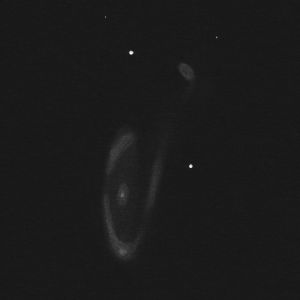
Uwe Glahn, 16", 257x, fst 6m5+:
NGC 5395:
Main part of NGC 5395 is elongated 2:1 N-S; bright core; a prominent arc starts
east of the core running south, it extends to the southern tip of the galaxy and
makes a slight bend to NW; at the southern end brighter and broader; a detached
spiral arm starts at the southern end, beeing brightest near the center and
beeing directed towards NGC 5394; at the northern end lies a 3:1 SE-NW elongated
knot
NGC 5394: elongated 2:3 NE-SW with homogeneous brightness distribution; a faint
thin arced extention starts at the SW end running towards NGC 5395; no extension
on the opposite side; 4' NE liea the round 15vmag faint IC 4356; did not look
for two further 16,5bmag faint galaxies in the field.

Messier 51, 8m1, 11.4' x 7.0', SA(s)bc pec
NGC 5195, 9m6, 5.8' x 4.6', I0 pec
Distance: approx. 20 MLy
Canes Venatici
Uranometria: S. 76 (old), S. 37-left (new)
DSS II (10' x 10')
further information:
SDSS Image
Messier45.com
Uwe Glahn, 20x125, fst 6m5:
companion already visible in the binos, with 16" bright spiral arms with lots of structure, many brighter spots inside the galaxy body, bridge between M 51 and the companion NGC 5195 hard to detect
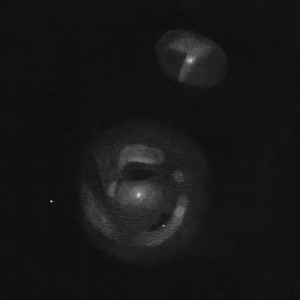
Martin Schoenball, 10",91-274x, fst 6m6:
M 51: Very large and bright. The spiral arms are hinted by several knots, but are not circumferential. A 13mag star lies at the inner side of a thin bright arm with a knot in the north. The center is round with extensions E-W. Further east lies a knot. It is difficult to get all details without having a known image in the mind!
NGC 5195: The central area is round and of higher surface brightness than M 51. The brightest part has the shape of a cone pointing towards M 51 and a round center in the middle. Towards E a quarder circle is attached. The slightly oval halo is rotated by 90 degrees against the cone. No visible connection to M 51.
Matthias Juchert, 2,5", fst 6m5:
Very bright, pretty large. Two overlapping disks in a common halo are visible at 34x with M 51 twice as large as NGC 5195. The Halo is elongated 3:1 N-S. Both objects show a very bright non stellar core.
Matthias Juchert, 8", fst 6m8:
Showpiece of a spiral galaxy. Very bright, very large, beautiful! At 98x two prominent clockwise spiral arms with dark bands between them are visible. The brightest parts of the arms are in SW and NW. A 13mag star lies at the inner side of a spiral arm in the southeastern part. Here two knots of light are detectable with averted vision. The one in N is fainter and nearly stellar, there southern one is clearly extended. The companion NGC 5195 shows a bright central area lying sideways in the halo forming the shape of a cat's eye. The halo is more evident and more extended in W. The connection between the two galaxies is difficult to detect.

NGC 7752, 14m0, 0.8' x 0.5', ? I0:
NGC 7753, 12m2, 3.3' x 2.1', SAB(rs)bc I
Distance: approx. 230 MLy
Pegasus
Uranometria: S. 89 (old), S. 45-right/63-right (new)
DSS II (5' x 5')
further information:
Messier45.com
Uwe Glahn, 16", 257x, fst 6m6:
NGC 7753 shows two spirals, brighter spiral
arm in the direction of the companion NGC 7752, NGC 7752 small, elongated, faint star between both galaxies

NGC 3808, 13m4, 1.7' x 0.9', SAB(rs)c pec
NGC 3808A, 13m7, 0.6' x 0.2', I0? pec
Distance: approx. 330 MLy
Leo
Uranometria: S. 147 (old), S. 72-right (new)
DSS II (5' x 5')
further information:
Messier45.com
not observed yet

NGC 2648, 12m0, 3.3' x 1.1', S1
PGC 24469, 15m5p, 1.1' x 0.3', Sc
Distance: approx. 95 MLy
Cancer
Uranometria: S. 186 (old), S. 94-left (new)
DSS II (5' x 5')
further information:
Messier45.com
Uwe Glahn, 20", 155x, fst 6m5:
NGC 2648 bright, elongated 1:2 NW-SE, diffus, bright and round core, companion faint 1:3 - 1:4 elongated glow, no core, both galaxies not connected visually

NGC 5929, 13m3, 1.0' x 0.9', SAB(s)bc I-II
NGC 5930, 12m2, 1.7' x 0.9', Sab: pec
Distance: approx. 110 MLy
Bootes
Uranometria: S. 78 (old), S. 35-right (new)
DSS II (5' x 5')
further information:
SDSS Image
Messier45.com
not observed yet

NGC 5953, 12m0, 1.6' x 1.4', SAa: pec
NGC 5954, 12m2, 1.3' x 0.6', SAB(rs)cd pec
Distance: approx. 90 MLy
Serpens Caput
Uranometria: S. 199 (old), S. 88-right (new)
DSS II (5' x 5')
further information:
Messier45.com
Matthias Juchert, 8", fst 6m2:
Interesting pair with NGC 5954. Both appear as one smudge at 50x.
NGC 5953: At 126x the special form of the system can be assumed. Both nebulae are equally bright and overlap. They are not arranged in east-west orientation. NGC 5953 is the larger of the two and has a roundish shape with a bright center.
NGC 5954 is the smaller component of the system a little fainter than NGC 5953. In contrast to photos this galaxy appears oval visually and not oblong.

NGC 3226, 11m4, 3.2' x 2.8', E2: pec
NGC 3227, 10m4, 5.4' x 3.7', SAB(s)a pec
Distance: approx. 55 MLy
Leo
Uranometria: S. 144 (old), S. 73-right (new)
DSS II (5' x 5')
further information:
Messier45.com
Martin Schoenball, 10", 150x, fst 5m5:
NGC 3226: Fainter one of the pair. Round, non stellar core.
NGC 3227: Moderately bright galaxy, elongated 2:1 NW-SE, bright stellar core and an even halo, brighter than its neighbor.
Matthias Juchert, 8", fst 6m1:
NGC 3226: At 50x direct vision - only little fainter than NGC 3227. Round shape with moderately bright center.
NGC 3227: A beautiful and bright pair of galaxies only 50' from Gamma Leonis. At 50x prominent with direct vision, clearly elongated nebula with a very bright central area.
Uwe Glahn, 16", 225x, fst 5m8:
similar brightness of both galaxies, NGC 3227 3:2 SE-NW elongated with faint halo and bright core, halo conatcts halo of NGC 3226 in the NW, NGC 3226 round with brighter halo and bright core

NGC 7547, 13m6, 1.1' x 0.5', (R' )SAB(s)0/a
NGC 7549, 13m2, 2.8' x 0.7', SB(s)cd pec
NGC 7550, 12m2, 1.4' x 1.2', SA0-
Distance: approx. 210 MLy
Pegasus
Uranometria: S. 169 (old), S. 64-left (new)
DSS II (10' x 10')
further information:
Messier45.com

Uwe Glahn, 16", 200x, fst 7m0:
dominating galaxy NGC 7750 round, diffuse, with a slightly brighter nucleus, NGC 7747 second brightest galaxy, elongated in direction of NGC 7750, NGC 7549 with two faint and short spiral
arms, NGC 7753, 7758 small, round